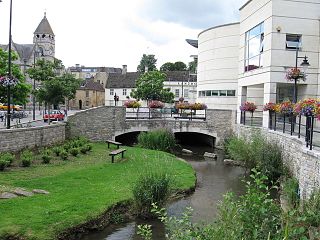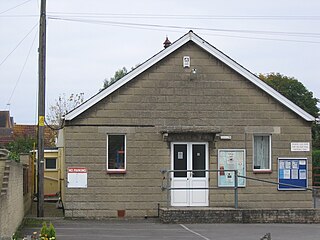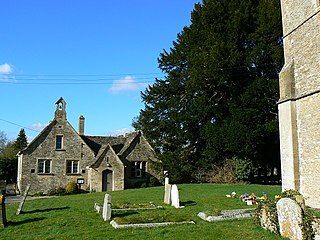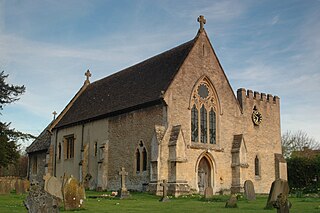
Wiltshire is a ceremonial county in South West England. It borders Gloucestershire to the north, Oxfordshire and Berkshire to the east, Hampshire to the south-east, Dorset to the south, and Somerset to the west. The largest settlement is Swindon, and Trowbridge is the county town.

Swindon is a large town in Wiltshire, England. At the time of the 2021 Census the population of the built-up area was 183,638, making it the largest settlement in the county. Located in South West England, Swindon lies on the M4 corridor, 71 miles (114km) to the west of London and 36 miles to the east of Bristol. The Cotswolds lie just to the town's north and the North Wessex Downs to its south.

The Kennet and Avon Canal is a waterway in southern England with an overall length of 87 miles (140 km), made up of two lengths of navigable river linked by a canal. The name is used to refer to the entire length of the navigation rather than solely to the central canal section. From Bristol to Bath the waterway follows the natural course of the River Avon before the canal links it to the River Kennet at Newbury, and from there to Reading on the River Thames. In all, the waterway incorporates 105 locks.

The Wilts & Berks Canal is a canal in the historic counties of Wiltshire and Berkshire, England, linking the Kennet and Avon Canal at Semington near Melksham, to the River Thames at Abingdon. The North Wilts Canal merged with it to become a branch to the Thames and Severn Canal at Latton near Cricklade. Among professional trades boatmen, the canal was nicknamed the Ippey Cut, possibly short for Chippenham.

The Thames and Severn Canal is a canal in Gloucestershire in the south-west of England, which was completed in 1789. It was conceived as part of a cargo route from Bristol and the Midlands to London, linking England's two largest rivers for better trade. The route climbs the steep Cotswold escarpment through the Golden Valley, tunnels underneath the summit of the Cotswold Edge, and emerges near the source of the Thames.

The Magic Roundabout in Swindon, England, is a ring junction constructed in 1972 consisting of five mini-roundabouts arranged in a circle. Located near the County Ground, home of Swindon Town F.C., its name comes from the popular children's television series The Magic Roundabout. In 2009, it was voted the fourth-scariest junction in Britain.

Melksham Without is a civil parish in the county of Wiltshire, England. It surrounds, but does not include, the town of Melksham and is the largest rural parish in Wiltshire, with a population of 7,230 and an area of 29 square kilometres.

Cricklade is a town and civil parish on the River Thames in north Wiltshire, England, midway between Swindon and Cirencester. It is the first downstream town on the Thames. The parish population at the 2011 census was 4,227.

The River Marden is a small tributary of the River Avon in England. It flows from the hills surrounding Calne and meets the Avon about a mile upstream of Chippenham. The river has a mean flow of 43 cubic feet per second (1.2 m3/s).

Bourton is a village and civil parish in the Vale of White Horse, England, about 4 miles (6.4 km) southeast of Highworth in neighbouring Wiltshire. Bourton was part of the parish of Shrivenham until 1867, and was in Berkshire until the 1974 local government boundary changes transferred the Vale of White Horse to Oxfordshire. The 2011 Census recorded the parish population as 326.

Foxham is a village in Bremhill civil parish in Wiltshire, England, about 5 miles (8.0 km) northeast of Chippenham and a similar distance northwest of Calne.
Hayes Knoll is a hamlet between Swindon and Cricklade in north Wiltshire, England. It is in the civil parish of Purton, about 0.8 miles (1.3 km) west of the village of Purton Stoke and 2 miles (3.2 km) south of Cricklade.

Semington is a village and civil parish in Wiltshire, England. The village is about 2 miles (3 km) south of Melksham and about 3 miles (5 km) northeast of Trowbridge. The parish includes the hamlets of Little Marsh and Littleton.

Swindon is a town in Wiltshire in the South West of England. People have lived in the town since the Bronze Age and the town's location, being approximately halfway between Bristol and London, made it an ideal location for the Locomotive Factories of the Great Western Railway in the 19th century.
Transport in Swindon, England, and the surroundings has directly contributed to the town's growth and the ingress of businesses and industries.

Latton is a village and civil parish in Wiltshire, England, 1.5 miles (2.4 km) north of Cricklade, on the county border with Gloucestershire. The village is bypassed by the A419 road from Swindon to Cirencester. The parish includes the hamlet of Eysey, formerly a village with its own church and parish.
The Cotswold Canals Trust is a British registered charity that aims to protect and restore the Stroudwater Navigation and the Thames and Severn Canal. Formed in 1972, the organisation has a goal to restore navigability on the two waterways between Saul Junction to the River Thames. Since then, it has overseen restoration of the waterways, with many bridges, locks, and cuttings being rebuilt and reinstated.

Mouldon Hill Country Park is a country park to the north west of the town centre of Swindon, within the parish of Haydon Wick and close to Thamesdown Drive. It is owned and managed by Swindon Borough Council.

East Challow is a village and civil parish about 1 mile (1.6 km) west of Wantage in the Vale of White Horse, England. Historically it was part of the ecclesiastical parish of Letcombe Regis, but since 1852 East and West Challow have formed their own single ecclesiastical parish. The civil parish was part of Berkshire until the 1974 boundary changes transferred the Vale of White Horse to Oxfordshire.
















